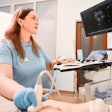Working effectively can be difficult when you're not getting enough sleep, and radiology residents are just as susceptible as other physicians to making errors after hours. The bottom-line question is how much these errors affect patient care. But according to a study published by researchers at Monmouth Medical Center (MMC), a community-based academic medical center in Long Branch, NJ, patients and attendings needn't worry: interpretations by on-call radiology residents can be trusted.
The MMC team reviewed interpretations of 11,908 radiology exams performed by on-call residents over a three-year period, from January 2002 to January 2005, for discrepancies with the attending radiologist's final interpretation (American Journal of Roentgenology, July 2007, Vol. 189: pp. 523-526). The interpretations were made between the times of 8 p.m. and 8 a.m.
The cases were organized by the imaging technique and diagnosis, resident's level of training, and impact of the discrepancy on patient care. When major inconsistencies were found, the patient's medical chart was reviewed as well, and discrepancies were organized as to the effect on patient morbidity. Discrepancy rates between resident and attending interpretations were also compared with RadPeer data from MMC, a Web-based peer-review tool offered by the American College of Radiology (ACR).
Studies included radiography; barium gastrointestinal examinations; CT scans of the head, neck, chest, abdomen, pelvis, and extremities; MR angiography run-off; and MR of the brain and spine. A major discrepancy was described as one that had potential to significantly affect patient care if not corrected, such as appendicitis; minor discrepancies were characterized by radiologic findings that did not have direct consequences on patient care, such as renal cysts.
Of the 11,908 cases reviewed, the researchers found 312 major and 2,545 minor interpretation discrepancies, for an overall discrepancy rate of 2.6%, comparable to MMC's RadPeer data, which found a rate of difference of 2.1%.
The effects of the interpretation differences between residents and attendings on patient management are listed below:
- No significant effect, 92.8%
- Some negative effect, 6.9%
- Significant negative effect, 0.3%
The exam most commonly identified in cases with resident/attending interpretation discrepancies was contrast-enhanced CT scans of the abdomen and pelvis. The most common missed or corrected diagnosis was acute appendicitis, with 21 cases. Of these 21 cases, 81% involved a false-negative or missed diagnosis, and 19% involved a false-positive or equivocal diagnosis. The second most commonly missed diagnosis was pulmonary embolism, with 17 cases total.
The rate of discrepancy was highest for third- and fourth-year residents; second- and fifth-year residents take six months or less of call annually, the study reported.
By Kate Madden Yee
AuntMinnie.com staff writer
September 19, 2007
ABR discusses changes in residency requirements, June 6, 2007
Major changes in the radiology residency program requirements are coming, December 5, 2006
Simple tracking program, case review scale back resident misreads, November 30, 2006
Revisiting report errors serves as educational tool for residents, December 22, 2005
Automated report tracking serves clinical, educational goals, January 18, 2005
Copyright © 2007 AuntMinnie.com




















